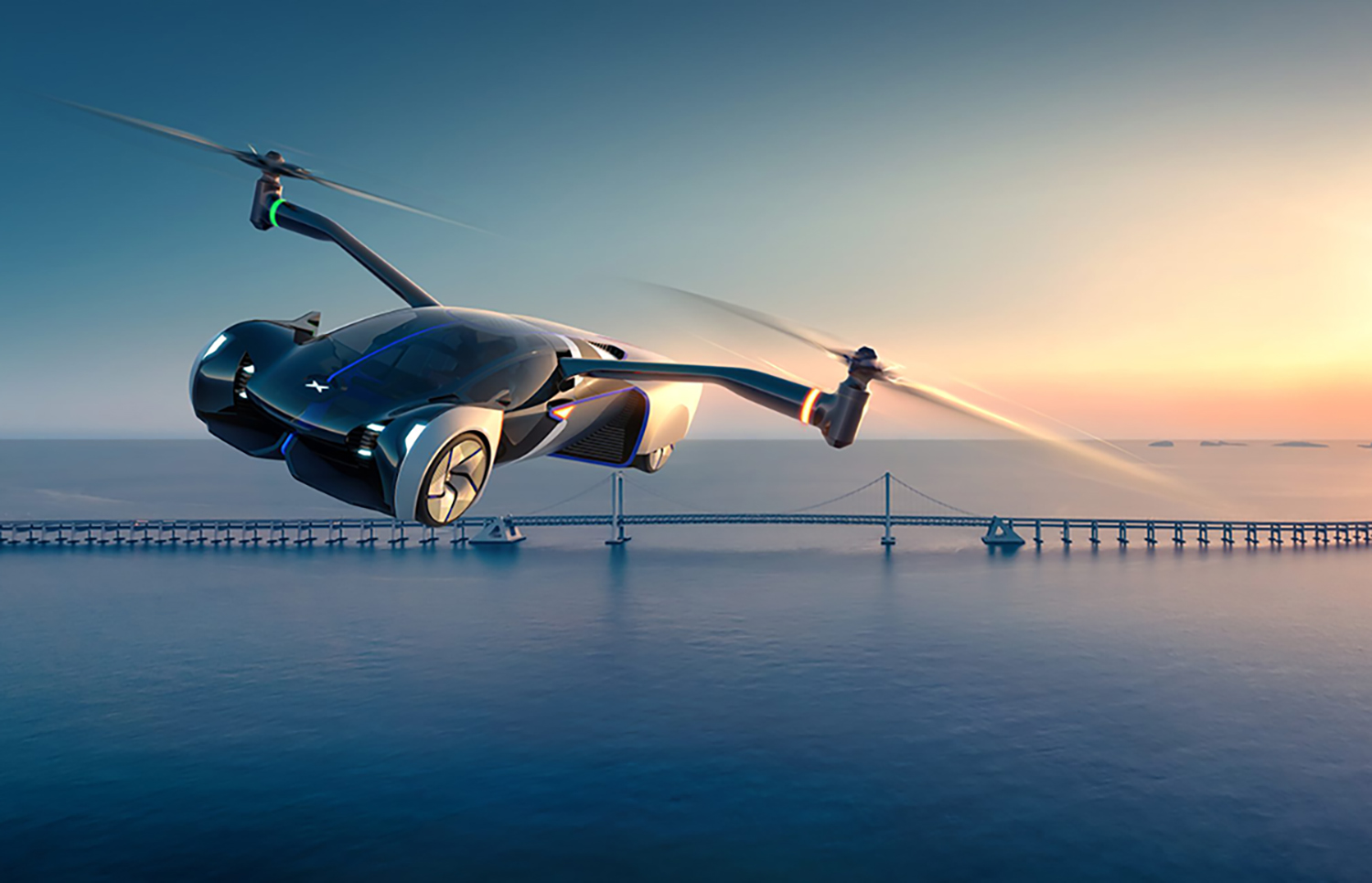小鹏飞行汽车要来了,轮子、翅膀、降落伞全副武装
中国电动汽车制造商小鹏汽车也加入了押注颇具未来主义色彩的飞行汽车的行列。10月24日,在小鹏汽车的科技日上,公司揭幕了一项最新设计——带有轮子和翅膀的飞行汽车。
小鹏汽车表示,这款尚未命名的飞行汽车将于2024年开始量产,零售价约为15.7万美元(约合100万人民币)。但是,由于管理空中汽车的监管框架尚未出现,目前也没有足够宽的道路来容纳飞行汽车的可伸展螺旋桨叶片,2024年这一最后期限,现在看起来似乎有些紧张。
值得注意的是,在无人驾驶航空旅行领域,小鹏已经面临着来自诸多竞争对手的挑战,包括初创公司和传统航空公司。波音公司(Boeing)在2019年投资了一项由保时捷(Porsche)负责开发的“飞行出租车”服务。在家门口,总部位于广州的亿航在2019年纳斯达克上市中筹集了4000万美元,而截至去年,公司已经售出了70台自己的“自主飞行器”。

亿航公司将其“自主飞行器”作为无人驾驶的空中出租车进行销售。这款飞行器可以作为运送公司高管往返机场的通勤机,甚至可以作为紧急服务车辆,用来救援被困在洪水或其他难以到达的地形上的受困者。单人舱的设计使它在功能上更像是“个人电动直升机”,而非真正的飞行汽车。
与之不同的是,根据小鹏的构想,他们的汽车真正能够在道路上和空中飞行。这款概念汽车的飞行由设置在可折叠臂上的双螺旋桨提供动力。可折叠臂在准备飞行时从车体两侧伸出,翼展达到12米左右。当其处于汽车模式时,机翼则会缩回到车内的一个隔间里。
这款新奇的飞行器由HT Aero公司设计。该公司是一家“城市空中机动”公司,由小鹏提供支持(为其子公司),于上周获得了5亿美元的A轮融资。该公司迄今已设计了6代飞行客运车辆,但目前销量仍为零。
但是,汽车行业咨询公司Sino Auto Insights的创始人兼首席执行官涂乐说,小鹏的飞行汽车是否真的能够落地,这其实不是重点;宣布飞行汽车的真正目的,是定义未来的“机动”(mobility)是什么样子。
“小鹏显然希望以挑战极限、成为技术最先进的‘机动’公司而闻名。”他说。生产一辆会飞的汽车,“即使销量有限,在目前对他们来说仍然利大于弊”。
其实,小鹏并不是第一家试图兜售飞行汽车理念的制造商。今年3月,中国汽车制造商吉利也宣布,将在2024年向中国市场推出一款飞行汽车。这一新兴行业的制造商似乎都瞄准了2024年,因为这是该领域腾飞的一年。
但是,涂乐表示,要让更广泛的监管环境“认真考虑这一点”,2024年似乎还为时太早。安徽省和江西省的一些地方政府已经开放了试验区,开发商可以在这些地方测试飞行出租车等“低空”交通工具。目前,还有一些安全问题需要解决。
小鹏表示,其飞行汽车将配备先进的环境传感器,以便在起飞前进行安全评估。但监管机构可能希望其采取更多措施,以减少这一款在头部高度部署了两个高速螺旋桨的汽车所带来的潜在健康和安全风险。
回到今年4月,中国政府就特斯拉(Tesla)的一辆汽车因自动驾驶系统刹车故障而坠毁一事,对公司高管进行了谴责。在谴责声中,特斯拉改变了最初拒绝与相关客户分享事故数据的做法,对其在中国的数据隐私做法进行了改革。尽管存在争议,但特斯拉今年在中国的销售仍保持快速增长。
小鹏的飞行汽车倘若出现故障,对其声誉带来的影响,很可能比特斯拉因自动驾驶系统故障所遭受的影响更大——但谢天谢地,这辆车配备了安全气囊,还有一顶降落伞。(财富中文网)
编译:杨二一
中国电动汽车制造商小鹏汽车也加入了押注颇具未来主义色彩的飞行汽车的行列。10月24日,在小鹏汽车的科技日上,公司揭幕了一项最新设计——带有轮子和翅膀的飞行汽车。
小鹏汽车表示,这款尚未命名的飞行汽车将于2024年开始量产,零售价约为15.7万美元(约合100万人民币)。但是,由于管理空中汽车的监管框架尚未出现,目前也没有足够宽的道路来容纳飞行汽车的可伸展螺旋桨叶片,2024年这一最后期限,现在看起来似乎有些紧张。
值得注意的是,在无人驾驶航空旅行领域,小鹏已经面临着来自诸多竞争对手的挑战,包括初创公司和传统航空公司。波音公司(Boeing)在2019年投资了一项由保时捷(Porsche)负责开发的“飞行出租车”服务。在家门口,总部位于广州的亿航在2019年纳斯达克上市中筹集了4000万美元,而截至去年,公司已经售出了70台自己的“自主飞行器”。
亿航公司将其“自主飞行器”作为无人驾驶的空中出租车进行销售。这款飞行器可以作为运送公司高管往返机场的通勤机,甚至可以作为紧急服务车辆,用来救援被困在洪水或其他难以到达的地形上的受困者。单人舱的设计使它在功能上更像是“个人电动直升机”,而非真正的飞行汽车。
与之不同的是,根据小鹏的构想,他们的汽车真正能够在道路上和空中飞行。这款概念汽车的飞行由设置在可折叠臂上的双螺旋桨提供动力。可折叠臂在准备飞行时从车体两侧伸出,翼展达到12米左右。当其处于汽车模式时,机翼则会缩回到车内的一个隔间里。
这款新奇的飞行器由HT Aero公司设计。该公司是一家“城市空中机动”公司,由小鹏提供支持(为其子公司),于上周获得了5亿美元的A轮融资。该公司迄今已设计了6代飞行客运车辆,但目前销量仍为零。
但是,汽车行业咨询公司Sino Auto Insights的创始人兼首席执行官涂乐说,小鹏的飞行汽车是否真的能够落地,这其实不是重点;宣布飞行汽车的真正目的,是定义未来的“机动”(mobility)是什么样子。
“小鹏显然希望以挑战极限、成为技术最先进的‘机动’公司而闻名。”他说。生产一辆会飞的汽车,“即使销量有限,在目前对他们来说仍然利大于弊”。
其实,小鹏并不是第一家试图兜售飞行汽车理念的制造商。今年3月,中国汽车制造商吉利也宣布,将在2024年向中国市场推出一款飞行汽车。这一新兴行业的制造商似乎都瞄准了2024年,因为这是该领域腾飞的一年。
但是,涂乐表示,要让更广泛的监管环境“认真考虑这一点”,2024年似乎还为时太早。安徽省和江西省的一些地方政府已经开放了试验区,开发商可以在这些地方测试飞行出租车等“低空”交通工具。目前,还有一些安全问题需要解决。
小鹏表示,其飞行汽车将配备先进的环境传感器,以便在起飞前进行安全评估。但监管机构可能希望其采取更多措施,以减少这一款在头部高度部署了两个高速螺旋桨的汽车所带来的潜在健康和安全风险。
回到今年4月,中国政府就特斯拉(Tesla)的一辆汽车因自动驾驶系统刹车故障而坠毁一事,对公司高管进行了谴责。在谴责声中,特斯拉改变了最初拒绝与相关客户分享事故数据的做法,对其在中国的数据隐私做法进行了改革。尽管存在争议,但特斯拉今年在中国的销售仍保持快速增长。
小鹏的飞行汽车倘若出现故障,对其声誉带来的影响,很可能比特斯拉因自动驾驶系统故障所遭受的影响更大——但谢天谢地,这辆车配备了安全气囊,还有一顶降落伞。(财富中文网)
编译:杨二一
Chinese electric-vehicle maker Xpeng has joined the ranks of futurists betting on a market for flying cars, unveiling a design for an electric vehicle with wheels and wings during the company’s Tech Day on Sunday.
Xpeng says the unnamed flying car—the X-wing? the Xpeng Locust?—will begin mass production by 2024 and retail for around $157,000. But with little regulatory framework in place to manage autos in the air and no roads wide enough to accommodate the vehicle’s extendable propeller blades, Xpeng’s 2024 deadline looks a little tight.
Remarkably, Xpeng already has numerous competitors in the unmanned aerial travel space, including both startups and legacy airlines. Boeing invested in a “flying taxi” service in 2019, developed by Porsche. Closer to home, Guangzhou-based eHang raised $40 million in a Nasdaq IPO in 2019 and, as of last year, had sold 70 units of its own “autonomous aerial vehicles.”
EHang markets its “autonomous aerial vehicles” as pilotless air taxis, good for ferrying high-flying executives to and from airports, or even as emergency service vehicles, for rescuing people trapped in floods or on other hard-to-reach terrain. The usually single-passenger pods are functionally more like personal electric helicopters than bona fide flying cars.
Xpeng's own flight of fancy, however, is designed to take to the roads as well as the air. Flight on the theoretical marque is powered by twin propellers set on foldable arms that, when primed for flight, extend from either side of the car’s body, giving it a wingspan of around 12 meters. The wings retract to a compartment inside the car when it is in car mode.
The newfangled flying machine is designed by HT Aero, an “urban air mobility” company backed by Xpeng, which raised $500 million in Series A funding last week. The Xpeng affiliate has so far devised six generations of flying passenger vehicles. It has sold zero units.
But whether Xpeng's flying car ever really gets off the ground is a little besides the point, says Tu Le, founder and CEO of auto industry consultancy, Sino Auto Insights. The real purpose of announcing a flying car is to define what the future of "mobility" looks like.
"Xpeng clearly wants to be known for pushing the envelope and being the most technologically advanced 'mobility' company," Le says. Producing a flying car, "even if only sold in limited quantities, is still a net positive for them at this point in time."
Yet Xpeng isn't the first manufacturer trying to sell the idea of a flying car. In March, China automaker Geely also announced it would launch a flying car into the China market in 2024. Manufacturers across the nascent industry appear to have homed in on 2024 as the year when the field takes off.
Le says, however, that 2024 still seems too soon for the broader regulatory environment to have "considered this seriously." Some local authorities in Anhui and Jiangxi provinces have already opened pilot zones where developers can test "low altitude airspace" vehicles such as flying taxis. There will be safety kinks to work out.
Xpeng says its flying car will be equipped with advanced environmental sensors to conduct safety assessments before takeoff but, presumably, regulators will want greater assurances that the company has taken steps to mitigate the potential health and safety risks of a car deploying two high-velocity propellers at roughly head height.
Hark back to April this year when the Chinese government reprimanded executives at Tesla over a reported autopilot brake failure that resulted in one of its vehicles crashing. The rebuke prompted Tesla to overhaul its data privacy practices in China, after initially refusing to share data from the crash with the involved customer. Despite the controversy, Tesla’s China sales continued apace this year.
Xpeng’s reputational fallout from a malfunctioning flying car would probably be greater than what Tesla suffered for its own autopilot woes. Thank goodness the car comes equipped with airbags—and a parachute.













